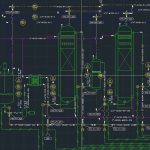That’s a real question. You must know as a graduate chemical engineer why it is so important. And with that, you will see why it is called as Piping and Instrumentation Diagram.
The fundamental objective of this diagram is as follows:
● This diagram is in a way a replica of the plant that is either to be erected, commissioned and run for a lifetime or it already exists. This diagram represents number of things about the plant facility but nothing as per scale:
1. Equipment
2. Utilities
3. Piping and fitting details
4. Instrumentation details
5. Control Loops
6. Offsite facilities
● This document is the primary document for detail engineering and number of other drawings and diagrams are made based on P&ID along with other documents:
1. To develop equipment list, line list, battery limits, etc
2. To make hookup diagrams.
3. To make single line diagram for power supply
4. Commissioning and Troubleshooting
5. Plant operation and maintenance
6. Risk Analysis
7. Operation and safety training
No matter what cap you wear under the roof of ChE or any other branch engineer, you will come across P&ID one or the other day.
Whether you work as a production engineer, safety engineer, process engineer, piping engineer, detail engineer, commissioning engineer, application engineer, or a third party consulting engineer, you must know – How to read, make, and review P&ID.


